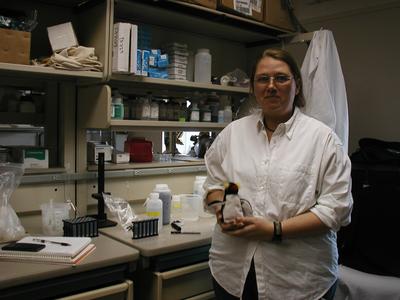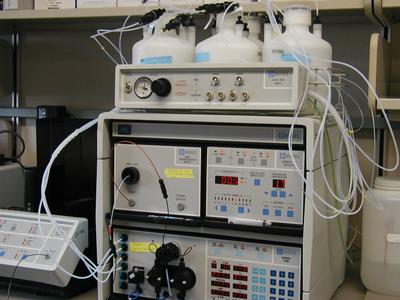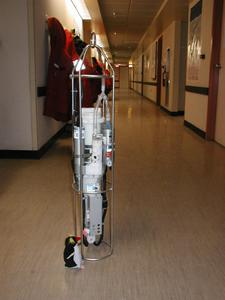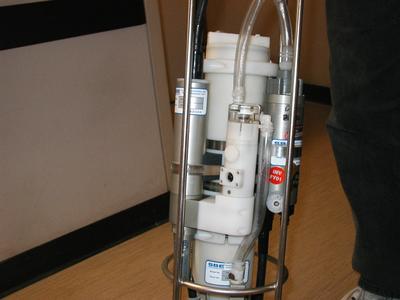
|
|
16 December, 2001

Kathy Welch, a research assistant (with a focus on geochemistry) with Berry Lyons at the Byrd Polar Research Center at Ohio State University in Columbus, Ohio, is in her ninth season conducting research in Antarctica with the LTER (Long-Term Ecological Research) program. Her fieldwork involves analyzing water samples from the lakes and streams by carrying out field sampling in the McMurdo Dry Valleys. She initially began polar research with Berry Lyons by studying ice cores in Greenland on three separate stints. (Ice cores help scientists see change in ice over time, which indicates climate variability). I met Kathy Welch and several members of the LTER science research group when we spent Thanksgiving together at Lake Hoare. This year 29 people are on the LTER field team conducting research in the McMurdo Dry Valleys. The LTER scientists have been collecting data in the Dry Valleys for the last nine years as part of an interdisciplinary study. The McMurdo LTER program involves comparing and relating research to different ecosystems: hydrology and water chemistry, climate/meteorology, glaciology, soil ecology, and limnology (study of lakes) to see how they affect each other. This enables scientists to get a clearer picture of what's happening to the environment over time. By collecting and analyzing data from each area, scientists gain a better understanding of this ecosystem, as well as the changes taking place in the world. (An ecosystem is an environment or an area where organisms live, as well as depend on certain parameters to survive. Changes and interactions within the ecosystem will affect the organisms and the environment either directly or indirectly.) The unique conditions in the McMurdo Dry Valleys make it one of the few places on Earth where changes can be seen almost immediately. The McMurdo LTER project is but one of 24 sites within the widespread LTER network to conduct long-term research to monitor changes in the ecosystem in the U.S. and Antarctica.

Kathy Welch uses this equipment to analyze the water field samples taken from the McMurdo Dry Valleys. I especially wanted to meet the LTER group because I was interested in the hydrology data collected from their lakes and streams. During my stay in Antarctica, ten 5th grade students and their parents from West Elementary (my school) have been collecting data once a week at a creek running through our town in Mt. Juliet, Tennessee. [They are using calibrated kits with the GLOBE program to check turbidity, temperature, pH, dissolved oxygen, conductivity, and alkalinity. The GLOBE program, Global Learning and Observations to Benefit the Environment (www.globe.gov), teaches students how to use scientific instruments to bring real science into the classroom. Thank you 2001-2002 West Hydrology GLOBE team: Brenda, Elijah, Cody, Marisa, Amanda, Stephanie, Laura, Donna, Matt, and James]. After the 911 tragedy, I could not bring chemicals from these kits on the plane to Antarctica. Fortunately, I was able to use a data logger, (Xplorer Pasport), from PASCO Scientific, to check temperature and pH at Explorers Cove. This equipment worked great in cold weather, even when my fingers were frozen. I felt fortunate to meet members of the LTER program because I felt this program would be beneficial, not just to my students, but to other classrooms involved with a hydrology study in their area. LTER has a wonderful website, http://huey.colorado.edu, with information and data, which I have personally found to be quite informative. Classroom teachers may also want to check out the McMurdo Schoolyard LTER site on this web page. I first heard about LTER through another TEA, Barb Schulz. You can find her web page at ../ ("Meet the Teachers", "Previous Antarctic Explorers", then scroll down to her name). Her field experience with the LTER program, as well as her classroom's involvement with the Schoolyard program, will provide more information about this wonderful program.

Research Assistants with the LTER program: Craig Wolf, Christine Foreman, and Thomas Nylen Craig Wolf (Montana State University) monitors ecosystem changes in the lakes, as well as collects data on changes, and how organisms are being affected by the changes. Dr. Christine Foreman is also with Montana State University in the Department of Land Resources and Environmental Sciences as a postdoctoral research associate studying microbial community in the McMurdo Dry Valley lakes. Thomas Nylen is with Portland State University monitoring the meteorology, atmosphere, and glaciers affecting the lakes and streams. The LTER program is monitoring three lakes in the McMurdo Dry Valleys: Lake Fryxell, Lake Hoare, and Lake Bonney. These lakes are closed basins that are fed by stream water from the runoff of glacier melt water. The past nine Antarctic summers have been colder with lower stream flows than the late 80's and early 90's. The lower stream flows mean less fresh water coming into the basins. Lake Bonney, 40 meters deep, is the saltiest of the three lakes. Lake Hoare, 30 meters deep, was formed by the Canada Glacier, but if the glacier retreats the melt water would go to Lake Fryxell. Lake Fryxell, the second saltiest lake, is a shallower lake (18 meters deep). The surface water in these lakes is super saturated with oxygen, but the oxygen level in the water becomes anoxic (poor oxygen) at deeper depths. No fish live in any of these lakes. Four meters of ice cover limit the light going through the ice, which in turn limits photosynthesis (plants making food from the sun's energy). Only microscopic organisms live in the lakes, and the food web is simple.

"Spike" is standing next to a CTD, an instrument used to measure the conductivity, temperature, and depth of the water column. The measurements determine if the water chemistry is being affected by the parameters of the environment (such as the saltiness of the water, temperature, glacier runoff, or carbon and nutrients in the water). The CTD can also measure changes as the seasons go from winter to summer state. As part of this interdisciplinary study, scientists have found that the organisms living in the lakes and streams are affected by small changes in the climate. Changes may be observed by collecting data on the atmosphere, lakes, streams, soils, and glaciers. Since glaciers are the main source of water leading into the streams and lakes, their melt water will impact the organisms living within the basins. Likewise, a change in climate can affect glacier melting and sublimation (changes from the solid state of ice to a gas without first becoming a liquid). A change in one ecosystem may affect another ecosystem as they interact.

The CTD measures the water column by pumping water through the system as it is lowered into the water through a hole in the ice. This instrument will measure the temperature at preset time intervals as it makes its way down through the water column. It will also measure salinity (salinity can be determined by knowing the conductivity and temperature). The CTD gives a profile of the water to help determine how the water conditions and changes in the water are affecting the organisms. These measurements are downloaded to a computer with a software program to store and manage data collected from the same locations over certain time periods during the season. The scientists at Explorers Cove, Art DeVries' research on fish with antifreeze, and the LTER program all use the CTD to collect data to determine if the water chemistry is affecting the ecology and organisms involved with their research.
Contact the TEA in the field at
.
If you cannot connect through your browser, copy the
TEA's e-mail address in the "To:" line of
your favorite e-mail package.
|
